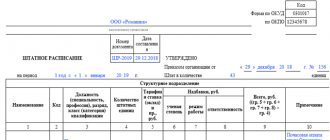Author: Ivan Ivanov
Calculating the efficiency of working time is one of the urgent tasks for modern organizations. If you know how many hours it will take to complete a certain job, you can fine-tune the execution process and increase overall labor productivity.
For these purposes, it is necessary to correctly calculate such an indicator as the number of man-hours. Special formulas with all comments and explanations help make the calculation simpler and more accessible.
General provisions
According to the standards mentioned in Art.
91 of the Labor Code of the Russian Federation, every employer is required to keep time records for all units of working personnel. For these purposes, companies have created timesheets that are allocated for each employee. Such documentation is maintained by a special department based on each division of the organization. These calculations allow you to set salaries and maintain various types of company statistics.
There are also situations when one timesheet is not enough, especially if the company is engaged in multi-level production that requires separate estimates. In this case, it becomes important to correctly determine the units of accounting time that correspond to one hour of work of one employee or calculate man-hours using a universal formula.
How are New Year holidays paid in 2021?
Calculation of additional payment for work on holidays If an employee has a monthly salary, then work on a weekend or holiday is paid based on the hourly or daily rate (in addition to the salary). In cases where the work was carried out within the monthly time limit, additional payment is paid in the amount of a single daily or hourly rate in addition to the salary.
If an employee has overworked the monthly norm, then the additional payment for work on a weekend or holiday is calculated using the formula: Additional payment on a weekend or holiday = Daily rate x 2 or Hourly rate x 2 x Number of working hours Daily rate = Employee salary: Number of days in a month for which the salary is calculated Hourly rate = Employee salary: Number of working hours per month The rules for remuneration on weekends and holidays have been clarified. Article 153 of the Labor Code of the Russian Federation has been supplemented with a new part. Moreover, in this case, it does not matter of fundamental importance what type of working week is established at a particular enterprise - you just need to select the appropriate section of the calendar:
- for workers with a 40-hour work week, the standard time in January 2021 will be 136 hours;
- for workers with a 36-hour work week, this norm will be 122.5 hours;
- for employees with a 24-hour work week, this figure will be 81.6 hours.
If the employee has a salary system, he must receive the full salary upon working the required amount of time. Thus, for them, paid holidays in January 2021 are the full duration of the New Year holidays established by law.
Man-hours: what they are and why they were introduced
The concept of “man-hour” is one hour of work by one employee. To put it simply, these are labor costs that are incurred to carry out one operation by one employee.
For a better understanding, let’s give a simple example: packer Svetlana Arkadyevna packs 40 packs of dumplings in 1 hour. When it comes to a real-life situation, things get more complicated. And the value of man-hour for each specific case will be different.
This accounting unit is optimal for planning working hours and identifying the number of employees required for a specific job. For example, the above situation with a packer helps the management of a dumpling shop easily calculate the average number of employees required to pack 400 packs of dumplings in 1 hour of work. This is only 10 people.
Among other things, such an accounting unit allows you to determine the timing of various types of work if the enterprise has a certain number of personnel.
For example, if there are not 10 packers, but only 5, in this situation the administrator cannot sell 400 packs to wholesalers, which will be packed in 1 hour of work. The production operation time is extended by 2 hours.
If we draw a general conclusion from all that has been said, this unit of accounting for labor costs is necessary for multi-stage work that requires mandatory compliance with deadlines for each of the production operations.
If you know the time required to complete a certain amount of work by one employee, it becomes possible to calculate the exact number of hours and the number of specialists for each stage of the production process.
When certain tasks have strict deadlines, management can use similar formulas and calculations to optimize work.
According to the law, the following periods are not counted as man-hours worked:
- employee internships and vacations;
- sick leave;
- production downtime;
- maternity and nursing leave;
- shortened days for workers;
- strikes;
- other cases of employee absence from work, regardless of the safety of wages.
How to calculate man-hours and man-days?
In order for the company to operate as efficiently as possible, it is very important to correctly distribute responsibilities between employees and give them the correct amount of time to complete each task. For these calculations, economic indicators such as “man-hour” and “man-day” are used.
They make it clear how quickly a particular employee is able to complete the task.
Every entrepreneur should be able to calculate them correctly, because these indicators not only help to correctly distribute the load, but are also extremely necessary when production is expanding.
With their help, they determine how profitable it will be to increase the staff, what positions more people can be hired for, etc. In addition, man-hours and man-days are needed to fill out various reports to the tax office. Therefore, you need to be able to calculate these indicators. How? We'll tell you below.
Man-hour
A man-hour is a unit equal to one hour of an employee’s working time. This indicator is used when calculating staff working hours or to determine the number of people to perform a task. But, of course, this indicator is most needed for tax reports. There is a special form P-4, which is submitted to Rosstat.
Calculation. Essentially, calculating man-hours is a calculation of the entire working time of an employee for the period indicated in the document. All working time means not only those hours that the employee must work under the employment contract, but also time outside work hours, as well as time on business trips.
The calculations do not include:
- The time when the employee was on sick leave or maternity leave;
- Employees' vacation time;
- Intra-shift downtime is a time when an employee, while at work, cannot perform his duties due to any external reasons beyond his control;
- Shortened working hours (due to holidays or by law for a specific employee, for example, if he is a minor);
- The absence of an employee from the workplace for other reasons.
Calculation formula . It's quite simple. Let us denote the man-hour indicator as “H”. The number of employees of the enterprise is “C”, and the operating time is “B”.
So we get H = C * B
Hours are usually taken per unit of time, but this may be another indicator (this must be indicated in the documents).
Calculation examples.
Example 1. A furniture assembly company employs 40 people. Their working day is a standard 8 hours. It is necessary to calculate the man-hour indicator for one working month - September. This September there are 20 working days. We substitute the indicators into the formula. To indicate the exact number of working hours, multiply the number of working days by hours. It turns out:
40 * 8 * 20 = 6400
This was an example of how the calculation should be done in principle. However, in reality, everything is very rarely so perfect. Some employees go on vacation in the middle of the month, some may get sick, some work part-time, etc. Let's give another example.
Example 2. 40 people work 8 hours a day. However, in September, employee Vasiliev worked only 10 days and then went on vacation.
Ivanov and Sidorov are students and work part-time. Employee Berezina was on maternity leave for the entire month. And citizen Petrov went on sick leave for 3 days.
It turns out that out of forty people, only 35 people worked full day, 8 hours, all 20 days.
We calculate the indicator for these 35 people using the formula: 35 * 8 * 20 = 5600
Then we count the number of hours for Vasiliev: 8 * 10 = 80
Part-time: 2 * 4 * 20 = 160
We don’t take employee Berezina into account at all. And for citizen Petrov, we subtract 3 days of sick leave from working days: 8 * (20 – 3) = 136
And then we add up all the resulting indicators: 5600 + 80 + 160 + 136 = 5976
The simplest formula and complicated calculations
The simplest calculation formula of all proposed is as follows:
K * T = Hh, where
Hh is the number of man-hours, K is the number of employees who work on a specific task, T is the period of time to complete the task.
Companies are required to submit reports to the Federal Tax Service, Pension and other funds of the Russian Federation, as well as regularly notify Rosstat about the number of employees and their salaries. To send information in accordance with Rosstat Order No. 407 dated July 24, 2012, the company’s accounting department fills out form P-4 and other related forms.
This paper records the number of all shifts worked. Overtime (worked during holidays) and travel allowance is added to the amount of time taken into account. For example, a company officially employs 8 specialists on a full shift, and 4 of them worked on holidays (let it be May 3 and 4) for 4 hours. The calculation will be as follows:
4 * 144 + 4 * 152 = 1184
Processing on a shift schedule
There are situations when, even with a shift schedule, overtime (i.e., working hours beyond the established norm).
The law requires payment for such situations at double the rate. What happens on holidays? Here the payment is also double. For clarity, here are a few examples:
EXAMPLE 1
At a housing management company, locksmiths work in shifts with a 2/2 schedule. Employee Klimov V.V. was assigned to work off-shift on November 4 due to a water line failure. The accident was resolved within 5 hours. Klimov has an hourly wage of 60 rubles/hour.
We calculate the additional payment:
60 rub. x 5 hours x 2 = 600 rub.
EXAMPLE 2
In May the standard hours are 143 hours. Employee Korovin T.T. worked 160 hours this month, working on a shift schedule. Of these, 8 hours on May 1 and 9 hours on May 9. The employee's salary is 40,000 rubles. Since the number of hours exceeds the norm this month, payment for holidays is subject to double payment (Article 153 of the Labor Code of the Russian Federation).
- We determine the hourly tariff rate: 40,000 rubles. : 143h. = 279.72 rub.
- We calculate the additional payment for holidays: (8 hours + 9 hours) x 279.72 x 2 = 9510.48 rubles.
All additional payments and salary allowances must be reflected in the employment contract. Do you work in the public sector and don’t know how to correctly calculate your long-service bonus? Our article will help you with this!
If you resign of your own free will, then you will find the material on payments upon dismissal of this type useful.
For statistics
The generalized number of man-hours is used to identify various types of statistical data based on the relevant reporting documentation. A striking example of this is a situation where an organization needs to transmit information about the size of the company, the salaries of various categories of personnel and the hours worked over a certain period.
The indicator for statistical data when filling out form P-4 is taken into account using the following formula:
Chh = Ch1 + Ch2 + … + Chn, where
Chh is the number of man-hours worked, Chn is the time for which the next employee works.
The calculation of the indicator includes all overtime and travel allowances that are included in the schedule.
Organization with part-time employees
For companies that employ both full-time and part-time employees, additional calculations often become necessary. If, for example, a company employs 3 accountants, 4 managers, 5 mid-level workers for a 3.5-hour shift per day, the calculations will be as follows:
12 * 144 = 1728
For the remaining 4 specialists, the calculations are as follows:
4 * (4 * 18) = 288
If one accountant is dismissed on May 12, the given formula for him determines the following value:
1 * (8 * 5) = 40
How to calculate salary for January 2021, taking into account holiday weekends
In November he worked 174 hours, of which 24 he worked on the holiday of November 4, Saturday and Sunday. The standard working time this month was 150 hours.
Info
The actual labor time exceeded the norm by 24 hours. In this case, the compensation amount is doubled. First of all, you need to calculate the employee's hourly rate.
To do this, the salary is multiplied by 12 (according to the number of months) and the resulting product is divided by the annual standard of working hours. In this case, the annual rate is 1920 hours. We calculate the hourly rate: (35,000 × 12) / 1920 = 218.75 (rub.) Based on this figure, you can calculate the amount of the surcharge: 24 × 218.75 × 2 = 10,500 (rub.) Now you can calculate the amount for November: 35,000 + 10,500 = 45,500 (rub.) The additional payment is calculated differently in the case where the employee worked on weekends, but the total number of working hours did not exceed the standard time for the month.
Case studies
No. 1. Let's say there are 200 employees working in the production department of a factory. Let's consider the calculation of the indicator for June:
200 (workers) * 8 (time allocated per shift) * 24 (working days this month) = 19200 (man-hours)
No. 2. To calculate the required value, you should use the total number of hours worked per day allotted to each employee in the accounting sheet. If we consider a small organization that employs 12 people on a standard 8-hour shift, the daily time limit will be:
12 * 8 = 96 man-hours
The result must be multiplied by the number of days in the month:
96 * 21 = 2016
If we calculate this indicator for each employee and rely on a 5-day work week and an 8-hour day, the result shows:
21 * 8 = 168
No. 3. The company is decommissioning 3 people. In July, the standard working time was 20 days, with a 40-hour week - 167. One employee closed his time sheet this month, another 1 worked only 144 hours (on July 24-26 he took leave without pay) and 2 employees worked 64 hours (with part-time work, 4 hours a day) and 18-20 ended up on sick leave, i.e. missed 3 working days).
The company also employs 1 part-time worker. In June he worked 80 hours (20 working days of 4 hours each). So, the total number of man-hours for June in this organization is:
167 + 144 + 64 = 542 man-hours
If we talk about external part-time workers, then this figure is 80.
No. 4. Let a municipal institution employ 9 people. Seven of them worked a full month on a 9-hour day shift. There are 21 working days in a month. So, each employee worked:
21 * 9 = 189 hours
One person worked only 99 hours, because... I was on vacation for 10 days:
(21-10) * 9 = 99 hours
The third employee worked 180 hours and had 4 hours of overtime:
(21 * 9) + 4 = 193
If we calculate the total number for all employees, the result will be as follows:
189 * 9 + 99 + 193 = 1993 man-hours
Calculation of standard man-hours
When calculating the standard man-hours for 2017-2018, you must adhere to the following rules:
- Sunday is recognized as a day off, regardless of whether the work week is five-day or six-day. It is only possible to transfer the day off for individual employees to another day if for some reason the company cannot suspend its activities for the weekend.
- The legislation (Article 112 of the Labor Code of the Russian Federation) establishes a list of holidays on which work is not carried out. The list is as follows: New Year holidays (January 1-6, 8), Christmas (January 7), Defender of the Fatherland Day (February 23), International Women's Day (March 8), Spring and Labor Day (May 1), Victory Day (9 May), Russia Day (June 12), National Unity Day (November 4).
- If the holiday coincides with a day off, then the rest day must be postponed. This rule applies to all holidays, with the exception of New Year holidays from the first to the eighth of January.
- The length of working days before holidays should be reduced by one hour.
The concept of labor costs in calculations
In addition to the accepted man-hours, there is the concept of “labor costs,” the formula of which is calculated using a similar calculation algorithm. The only difference is that a specific amount of time and labor units used are set for the work process (the calculation includes the cost of a certain job per hour).
Labor costs in general calculations are labor intensity, the formula of which is:
Tp = Тз / About, where
Tp – labor intensity, Тз – labor costs, About – volume of work performed.
There are different types of labor intensity indicator:
- full (total);
- technological (calculated based on work stages, number of parts, products, etc.);
- production (worker costs per product).
To this list is added the labor intensity of maintenance, which is allocated to auxiliary work processes associated with servicing production, as well as the labor intensity of management.
If we draw a conclusion about the difference between man-hours and labor costs, the difference lies only in the indicator of labor or time taken as a standard.
Payment for holidays and weekends in 2021
Attention
These categories include:
- disabled people;
- mothers and fathers raising without a spouse, as well as guardians of children under the age of five;
- women with children under three years of age;
- parents and guardians of disabled children;
- workers who care for a sick family member based on a medical certificate.
To attract them to work, it is necessary not only to obtain written consent, but also to make sure that such work is not prohibited for them in a medical report due to health reasons. How are New Year's holidays paid in January 2021 with a shift schedule? At some enterprises, the production cycle cannot be stopped even on holidays. As a rule, such companies have a shift schedule. To register work on holidays, in this case there is no need to issue any additional orders or instructions.
Where are they used?
Recording of man-hours and their costs is carried out in all organizations where there are hired employees. This value shows the hours allocated for work and the hours actually worked by all personnel. Various types of time are taken into account:
- calendar - the period of work of personnel, taking into account weekends and holidays;
- time-sheet - the time of the previous indicator minus days not intended for work;
- maximum - the number of hours possible for each employee to perform work during the reporting period;
- real - the time during which the employee actually performs his activities.
Another purpose of man-hours is used to calculate labor time, which is calculated using the formula:
K = Td / Tdr, where
K is the time allotted for work, Td is the actual hours worked, Tdr is the optimal number of hours.
Payment for holidays in January 2021
The method for calculating them is not defined by law, but in practice several methods are used:
- the employee’s monthly salary is divided by the standard working time according to the production calendar;
- the monthly salary amount is divided by the standard working time according to the employee’s individual schedule;
- salaries for the year are summed up, and the resulting figure is divided by the norm that the employee must work during the year.
Examples of salary calculations when using a salary system at an enterprise If an employee worked during rest periods in excess of normal working hours in the current month, his earnings include a double rate for a day or hour of work on weekends and a monthly salary. Let us give an example of calculating wages in this case. For example, the salary of mechanic Tkachev P.
B. is 35,000 rubles.
Other similar quantities
This category of indicators includes a man-day - working time in a day, which on average lasts 6, 8, 9 and 12 hours. This indicator does not depend on the actual time worked and is most often used for planning projects with a possible long period of their implementation.
The day is used in the calculation of data such as:
- number of shifts worked;
- number of appearances and absences;
- downtime.
The categories of indicators with actual values include:
- days the employee is at the workplace and performs his direct duties;
- periods of business travel;
- cases of whole-day downtime, due to which employees performed related work.
A full-day period of downtime is understood as a whole working day when a specialist showed up to perform his duties, but was unable to start due to circumstances beyond his control.
The latter may be a lack of resources or equipment malfunction. Often in such cases, the management of the organization warns employees in advance about the problematic situation and allows them to miss a day of work.
If you calculate the total number of appearances, you should determine the sum of all days worked and downtime. Absences are calculated based on the following types of employee absence from the workplace:
- internship and vacation;
- absence due to illness;
- absences from work related to the performance of government duties;
- absence at your own expense (without pay);
- absenteeism (absence without good reason), etc.
Based on the man-day, auxiliary quantities are constructed:
- week - 5 or 6 person days, depending on the main value;
- month - 20-24 calendar days of working time;
- quarter - 3 working months;
- year and other values.
How to correctly calculate man-hours and man-days
Personnel Man-hour and man-day are units of working time, corresponding to one working hour or day, respectively.
This article will help you understand these terms in more detail. We'll tell you why such a calculation is needed and how to calculate man-hours for statistics. January 14, 2021 Chekanova Yana
This is a unit of time recording that corresponds to one hour of work by one person.
The term "man-hour" is used for:
- planning working time for a particular job;
- determining the number of workers required to perform a particular process;
- filling out the statistical observation form P-4.
The calculation of man-hours is carried out by personnel department employees who know how to calculate the number of man-hours worked for the P-4 form. When calculating, only the time of actual labor is taken into account. Vacation, sick leave, and other paid or unpaid time during which work was not performed is not taken into account.
Calculation of man-hours: formula
Let's consider how to calculate the number of man-hours worked? The calculation algorithm is quite simple:
HH = HH1 + HH2 + … + HHn,
Where:
- HH - total amount of time worked;
- HH1 - how long the first employee worked;
- HH2 - how much the second worked;
- HHn - how much the nth person worked.
Formula for calculating man-hours per year
Sometimes it is necessary to determine indicators for the year. In this case, a similar formula is used, but with the difference that in it HH1, HH2 and HHn indicate how much each employee worked during the year.
It is usually used to fill out statistical reports.
For example, to calculate man-hours for 9 months of 2021 (when submitting quarterly statistical reports) or to calculate the number of man-hours worked since the beginning of the year for P-4.
The calculation of man-hours includes overtime, time spent on business trips by the employee, and also takes into account work on weekends or holidays.
The following do not need to be taken into account when calculating man-hours:
- the period of illness of the employee on sick leave;
- the time when the employee did not work for reasons that did not depend on him;
- time of annual leave;
- reduced working hours;
- the time when the employee improved his qualifications while away from work;
- time of employees' participation in strikes;
- other reasons for absence from work.
Example of calculating man-hours
Let's look at an example of how to calculate man-hours for statistics; we will use the formula given above.
Let’s say that a budget organization employs 10 people. Eight of them worked a full month with an 8-hour working day. There are 22 working days in a month. This means that each of these employees worked:
One person only worked 88 hours because he was on vacation for 11 days:
And another person worked 180 hours because he worked 4 hours overtime:
Thus, the total result for all employees will be:
176 × 8 + 88 + 180 = 1676 man-hours.
Similarly, you can calculate the number of man-hours worked for 2021.
What is a man-day
This is a unit of measurement of working time, corresponding to one working day of a person, regardless of the amount of time worked.
Man-days are used to calculate indicators such as:
- days worked;
- turnout;
- no-shows;
- all-day downtime.
The days worked in this case include:
- days of actually being at work (performing one’s duties at the main workplace);
- days spent on business trips;
- days when, due to forced downtime, the employee is involved in other activities of the enterprise.
An all-day downtime is a period when an employee showed up for work, but was unable to begin work due to reasons beyond his control. For example, there were no materials, the equipment was faulty, there were no spare parts. Or if the employee was warned by the administration in advance about the current situation and therefore did not show up for work.
In order to obtain the overall turnout rate, it is necessary to sum up the days worked and all-day downtime.
Finally, no-shows in this calculation include:
- all types of leaves (annual and educational);
- periods of illness documented with sick leave;
- absences in connection with the performance of state and public duties, days of blood donation and other cases of absence from work permitted by law;
- absence from the workplace in agreement with management without pay, for example, leave at your own expense;
- absenteeism, i.e. absence from work without good reason.
Above we looked at how to calculate man-hours for the P-4 form. Man-days in this regard are less informative and accurate, so they are not used in statistical reports.
Formula for calculating man-days
The calculation is quite simple. To determine this indicator, the following formula is used:
BH = ((Ch1 + Ch2 + … + Chn) × KDM) / 8,
Where:
- BH - the desired value;
- Ch1, Ch2, Chn - how long each employee worked;
- KDM - the number of calendar days in a month.
The article was prepared using materials from ConsultantPlus. Get access
Source: https://gosuchetnik.ru/kadry/kak-pravilno-poschitat-cheloveko-chasy-i-cheloveko-dni
Cost for 2021
The indicator is calculated based on the number of employees who are busy performing a particular job and the number of hours that they actually worked for themselves.
If a specialist in 2021 fulfilled the full standard of allotted time according to the worksheet of a 40-hour work week, the number of man-hours will be equal to 1970.
If the number of personnel at the enterprise is equal to 20 units and full compliance with the allotted norm, the annual value of man-hours will be equal to 39,400.
It is important to remember that the number of man-hours per year should be calculated on the basis of timesheets and other documents recording working hours by calculating the sum of hours allocated to perform the duties of each specialist. This means that you can calculate the annual value of man-hours based on the following algorithm:
ChChg = ChG1 + ChG2 + …. + CHGn, where
ChChg is the total number of man-hours worked per year by all employees, ChGn is the total time for which the nth specialist actually worked.
This algorithm is a formula for calculating the actual number of man-hours worked per year. Such records can only be kept from the beginning of next year. The number of man-hours in the current period represents a planned value, which is only recommended to be adhered to.
The annual indicator until the end of the period can only be calculated based on the production calendar, which provides information about vacations, plans for hiring new personnel and other characteristics related to the movement of work units and control of working time.
As stated earlier, information on the number of man-hours worked in 2021 is only an approximate forecast.
Example: for 5 company employees who work a 40-hour week throughout the year with timely vacations (160 hours) and about 35 hours on sick leave, the calculated number of man-hours in the current year will be as follows:
(1970 – 160 — 35) * 5 = 8875
Determination of the annual rate
Before moving on to the concept of standard man-hours, you should understand the concept of standard labor time. The standard working time is the total number of hours that an employee must work in a certain period of time.
The standard man-hours in 2017-2018 are calculated in accordance with the procedure determined by the order of the Ministry of Health and Social Development. In accordance with it, the length of the week (usually forty hours, in some cases less) should be divided by five, and then multiplied by the number of working days in the year (if the working week consists of five days). After which, from the resulting value it is necessary to subtract the number of hours by which working days were reduced before the holidays.
The annual rate must be calculated before the end of the previous calendar year, taking into account the provisions of the Labor Code, as well as annually issued Government Decrees on the postponement of holidays that coincide with weekends.










